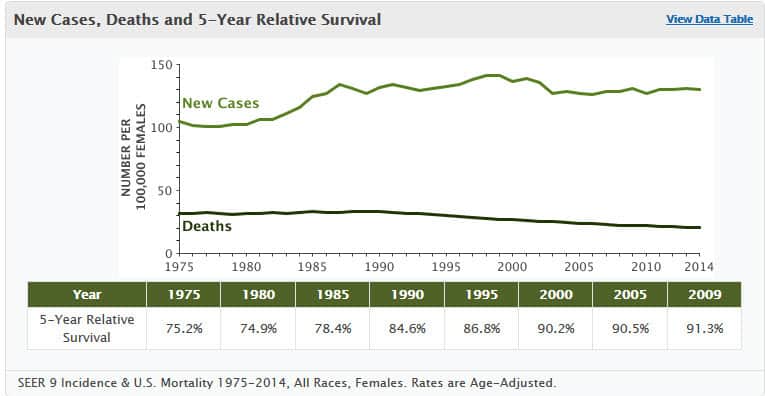Julia Louis-Dreyfus Diagnosed with Breast Cancer

Earlier this September Julia Louis-Dreyfus was flying high, having one her sixth straight Emmy for playing Selina Meyer on the HBO hit comedy Veep. Only a day later, she learned that she had been diagnosed with breast cancer. She took to social media on Thursday to make the announcement:
“1 in 8 women get breast cancer. Today, I’m the one. The good news is that I have the most glorious group of supportive and caring friends, and fantastic insurance through my union. The bad news is that not all women are so lucky, so let’s fight all cancers and make universal health care a reality.”
Louis-Dreyfus, 56, also known for her classic roles on Saturday Night Live, and as Elaine Benes on Seinfeld, did not give any specifics about the type or stage of breast cancer, nor how she plans to be treated.
Well wishes immediately poured in from fellow actors, cast mates, and even from former Vice-President Joe Biden, saying: “We Veeps stick together. Jill and I, and all of the Bidens, are with you, Julia.”
HBO announced that they will work around her treatment schedule in filming her final season of Veep.
“Our love and support go out to Julia and her family at this time. We have every confidence she will get through this with her usual tenacity and undaunted spirit, and look forward to her return to health and to HBO for the final season of Veep.”
Some Breast Cancer Basics
In the United States, breast cancer is the second most common cancer in women after skin cancer. The National Cancer Institute estimates that 252,710 women will will diagnosed with breast cancer in 2017. Almost 41,000 women will die of the disease this year.
The above graph is interesting in that it shows a number of trends in breast cancer over the past 35 years:
- The initial increase in new cases of breast cancers between 1975 and 2000 was probably due to increasing numbers of mammograms done due to:
- increased public awareness
- greater availability
- guidelines by major medical groups that included routine mammogram screening
- insurance coverage of the procedure by more insurance plans
- Since 2000, the number of new cases has either slightly decreased, or at least remained steady
- There has been a dramatic improvement in 5 year survival
Causes of Breast Cancer
Cancer is caused by mutations in the DNA that makes up our genes. Human beings have about 20,000 genes; but only about 160 of these are directly related involved in cancer, and only a handful are considered to be the main “drivers” of breast cancer.
DNA mutations can occur in either germ or somatic cells of the body. Germ cells are either sperm or eggs, and are responsible for transmitting genes from parent to child. Somatic cells refer to all of the other cells in your body. Mutations in somatic cells of the breast are the cause of the vast majority (90-95%) of breast cancers. These cancers do not run in families.
Hereditary cancers, on the other hand, are defined by mutations in germ cells, and the risk of developing cancer is passed between generations. The most common hereditary breast cancers are those of BRCA1 and BRCA2, which we have reported on previously.
Types of Breast Cancer
In the past, cancer has been defined two two things: 1. by the organ from which it arises, and from what structure within that organ it’s cells originate; and 2. What the cancerous cells looked like under the microscope. In breast cancer, cancers were defined primarily as coming from the milk ducts which carry milk to the nipples (ductal carcinomas) or from the lobules where milk is produced (lobular carcinoma). A number of variations of how these tumors looked under a microscope divided the types of breast cancer into at least 35 different types.
Since the late 1990’s, the diseases we call cancer have been undergoing a fundamental rethinking based on molecular features too small to be seen using a normal microscope. Most often, these features are abnormal versions of genes (DNA) or proteins that are the actual cause(s) of cancer or that drive a tumor’s dangerously uncontrolled growth and behavior.
Practically speaking, from a drug treatment point of view, there are three major types of breast cancer. So it’s important for doctors to diagnose exactly what type a patient has. The three major types of breast cancer and their treatments are:
- ER/PR-positive (or ER/PR+). About 65% of breast cancers are in this category. ER stands for “estrogen receptor,” PR stands for “progesterone receptor” and these tumors are treated with drugs such as as tamoxifen that block these hormones that act like fertilizers for the cancer cells.
- HER2-positive (or HER2+). About 20% of breast cancers are in this category. HER2 stands for “human epidermal growth factor receptor number 2.” The HER2 gene is amplified in this form of breast cancer and acts like an accelerator for cancer cells. These gene is blocked by a drug called traztusumab or HERCEPTIN.
- Triple-negative (TNBC) simply means that this type of cancer lacks the 3 “biomarkers” (ER, PR and HER2) that define the other two types. About 15% of breast cancers are in this category. Triple-negative cancers are treated with harsher chemotherapies because of a lack of “targets” for more modern drugs.

Interestingly, most BRCA1 (hereditary) breast cancers are in the TNBC category but not all TNBCs have the BRCA1 mutations. For more about hereditary breast and ovarian cancers, see our earlier stories on Angelina Jolie and Pierce Brosnan’s adopted daughter.
Signs and Symptoms of Breast Cancer
These and other signs may be caused by breast cancer or by other conditions. Check with your doctor if you have any of the following:
- A lump or thickening in or near the breast or in the underarm area.
- A change in the size or shape of the breast.
- A dimple or puckering in the skin of the breast.
- A nipple turned inward into the breast.
- Fluid, other than breast milk, from the nipple, especially if it’s bloody.
- Scaly, red, or swollen skin on the breast, nipple, or areola (the dark area of skin around the nipple).
- Dimples in the breast that look like the skin of an orange, called peau d’orange.
Much more information about breast cancer, treatment, surgery, reconstruction, side effects of treatment can be found in our book, Reimagining Women’s Cancers.





























0 comments